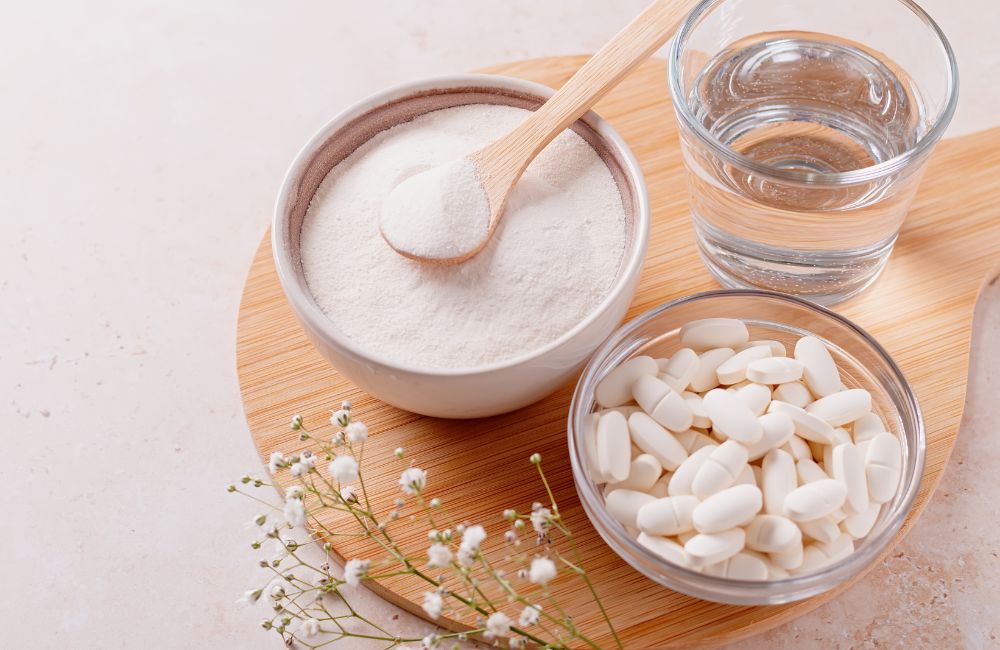Collagen, often called the “scaffolding of the skin,” maintains the skin’s strength, elasticity, as well as its youthful appearance. Our bodies naturally lose collagen as we age, causing wrinkles, sagging skin, and volume loss.
Fortunately, various medical processes are available for stimulating collagen production and rejuvenating the skin.
Read on to discover how you can achieve a more refreshed complexion with these procedures.

Table of Contents
Why is Collagen Important?
Collagen, a vital protein, holds the esteemed position of being the most prevalent structural protein found in the animal kingdom. Structural proteins are the fundamental building blocks that constitute the framework of our cells and tissues. There are 28 types of collagen in the human body, with type I collagen being the most abundant, making up 90% of the body’s collagen. Collagen is present in skin, tendons, bones, connective tissue, and cartilage, providing structural support to these parts.
Collagen and collagen-derived substances have a wide range of medical applications, including treating wounds, burns, and diabetic ulcers. Additionally, collagen plays an important role in cosmetics. Skincare companies harness collagen’s moisturizing and humectant capabilities, infusing them into products like creams and serums designed to enhance skin hydration and overall health.
Factors Affecting Collagen Production
Several factors contribute to the decline in collagen production:
- Age: As we reach our mid-20s, the production of collagen decreases, which leads to the appearance of fine lines and wrinkles.
- UV Exposure: Prolonged exposure to the sun can damage collagen fibers, leading to premature aging, such as sunspots and sagging skin formation.
- Smoking: Smoking reduces blood flow to the skin, impeding collagen production and accelerating aging.
- Poor Diet: Inadequate nutrition can deprive the body of essential amino acids and vitamins for collagen synthesis.
Medical Procedures to Stimulate Collagen Production
Fortunately, advancements in medical aesthetics provide a range of processes that actively stimulate collagen generation and effectively reverse the signs of aging. These cosmetic procedures are categorized into non-invasive, minimally invasive, and surgical, allowing you to choose based on your specific goals and preferences.
1. Non-Invasive Procedures
- Dermal Fillers: Dermal fillers, such as hyaluronic acid fillers, Sculptra, and Radiesse, work by restoring lost volume and boosting collagen. These collagen-building injections are injected into specific areas to plump the skin and reduce wrinkles.
- PRF Therapy: Platelet-rich fibrin (PRF) therapy is a natural and effective method for stimulating collagen production in the skin. This innovative treatment involves the extraction and concentration of platelets and growth factors from the patient’s own blood, which are then applied to the skin. PRF therapy encourages collagen synthesis, leading to skin rejuvenation, improved texture, and diminished wrinkles.
- Microneedling: Microneedling involves using tiny needles to create controlled micro-injuries in the skin. This process triggers the body’s natural healing response, including collagen production. Combining microneedling with Platelet-Rich Plasma (PRP) can enhance results.
- Laser Therapies: Fractional laser resurfacing and CO2 laser therapy use laser energy to remove damaged skin cells and promote collagen regeneration. These treatments can improve skin texture and reduce the appearance of scars and wrinkles.
2. Minimally Invasive Procedures
- PDO Thread Lift: PDO (Polydioxanone) threads are inserted beneath the skin to lift and tighten sagging areas. Over time, these threads stimulate collagen formation, further enhancing the results.
- Chemical Peels: Chemical peels involve the application of a chemical solution to the skin, causing controlled exfoliation. This process not only removes damaged skin layers but also encourages collagen synthesis.
- Radiofrequency Skin Tightening: Anti-aging treatments like Thermage and Profound RF use radiofrequency energy to heat the deeper layers of the skin, promoting collagen remodeling and skin tightening.
3. Surgical Procedures
- Facelift: Whether traditional or mini, Facelift surgery entails lifting and repositioning drooping facial tissues. Additionally, the manipulation of tissues enhances the synthesis of collagen.
- Fat Transfer: Fat transfer procedures involve harvesting fat from one part of the body and injecting it into areas that require volume, restoring lost volume, and increasing the amount of collagen in the treated areas.
- Fractional CO2 Laser Resurfacing: Fractional CO2 laser resurfacing stimulates collagen regeneration and can treat severe skin damage in advanced cases.
4. Collagen-Stimulating Skincare
In addition to these medical procedures, collagen-stimulating skincare products can complement your efforts to maintain and enhance collagen production. Topical retinoids, collagen-boosting serums, and skincare devices like microcurrent and LED light therapy can contribute to healthier, more youthful skin.
5. Collagen Supplements
Collagen supplements are ingestible products designed to increase the body’s collagen levels. They come in various forms, including capsules, tablets, powders, and liquids. Animals like cows, pigs, or fish are the typical sources for deriving collagen supplements.
In a Japanese study, 66 women over 40 received either 10g of collagen peptides daily for 56 days or a placebo. Significant improvements were observed in skin moisture for the collagen group compared to the placebo; French women over 40 included in this study showed identical outcomes.
Final thoughts
Collagen production is essential for maintaining youthful and healthy skin. While natural aging leads to a decline in collagen, various medical procedures can help stimulate its production, effectively turning back the clock on aging. The choice of which method to pursue stimulating collagen production may depend on individual goals and skin concerns, but all of these approaches have shown promising results in helping individuals achieve smoother, younger-looking skin.